Operations and Project Management: A Case Study of TESCO
VerifiedAdded on 2023/06/07
|14
|4594
|294
AI Summary
This report is a case study of TESCO and focuses on the principles of operation management, lean principles, continuous improvement, project life cycle, six sigma and project methodology and tools which are used for a specific project with proper conclusion and findings.
Contribute Materials
Your contribution can guide someone’s learning journey. Share your
documents today.

Operations and Project
Management
Management
Secure Best Marks with AI Grader
Need help grading? Try our AI Grader for instant feedback on your assignments.
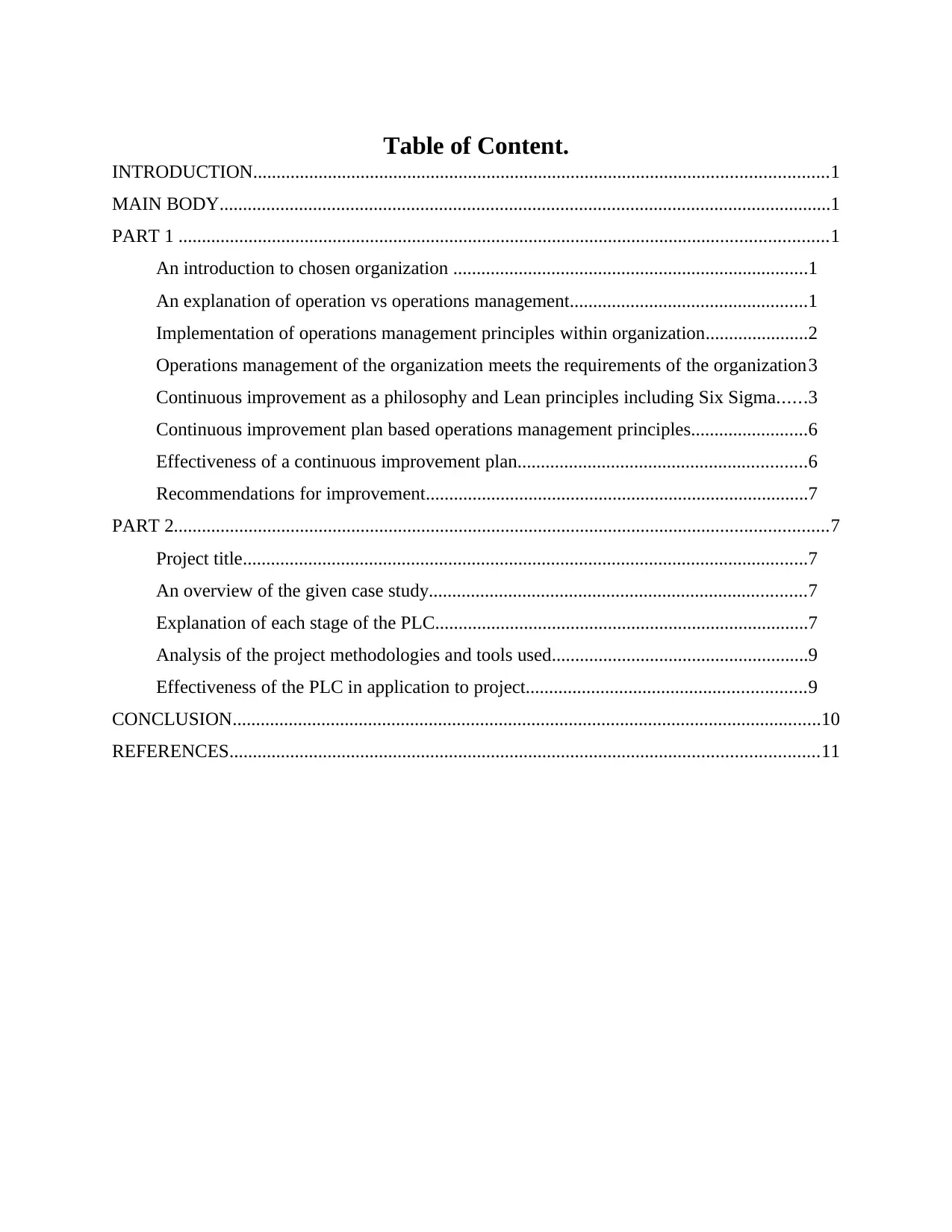
Table of Content.
INTRODUCTION...........................................................................................................................1
MAIN BODY...................................................................................................................................1
PART 1 ...........................................................................................................................................1
An introduction to chosen organization ............................................................................1
An explanation of operation vs operations management...................................................1
Implementation of operations management principles within organization......................2
Operations management of the organization meets the requirements of the organization3
Continuous improvement as a philosophy and Lean principles including Six Sigma......3
Continuous improvement plan based operations management principles.........................6
Effectiveness of a continuous improvement plan..............................................................6
Recommendations for improvement..................................................................................7
PART 2............................................................................................................................................7
Project title.........................................................................................................................7
An overview of the given case study.................................................................................7
Explanation of each stage of the PLC................................................................................7
Analysis of the project methodologies and tools used.......................................................9
Effectiveness of the PLC in application to project............................................................9
CONCLUSION..............................................................................................................................10
REFERENCES..............................................................................................................................11
INTRODUCTION...........................................................................................................................1
MAIN BODY...................................................................................................................................1
PART 1 ...........................................................................................................................................1
An introduction to chosen organization ............................................................................1
An explanation of operation vs operations management...................................................1
Implementation of operations management principles within organization......................2
Operations management of the organization meets the requirements of the organization3
Continuous improvement as a philosophy and Lean principles including Six Sigma......3
Continuous improvement plan based operations management principles.........................6
Effectiveness of a continuous improvement plan..............................................................6
Recommendations for improvement..................................................................................7
PART 2............................................................................................................................................7
Project title.........................................................................................................................7
An overview of the given case study.................................................................................7
Explanation of each stage of the PLC................................................................................7
Analysis of the project methodologies and tools used.......................................................9
Effectiveness of the PLC in application to project............................................................9
CONCLUSION..............................................................................................................................10
REFERENCES..............................................................................................................................11
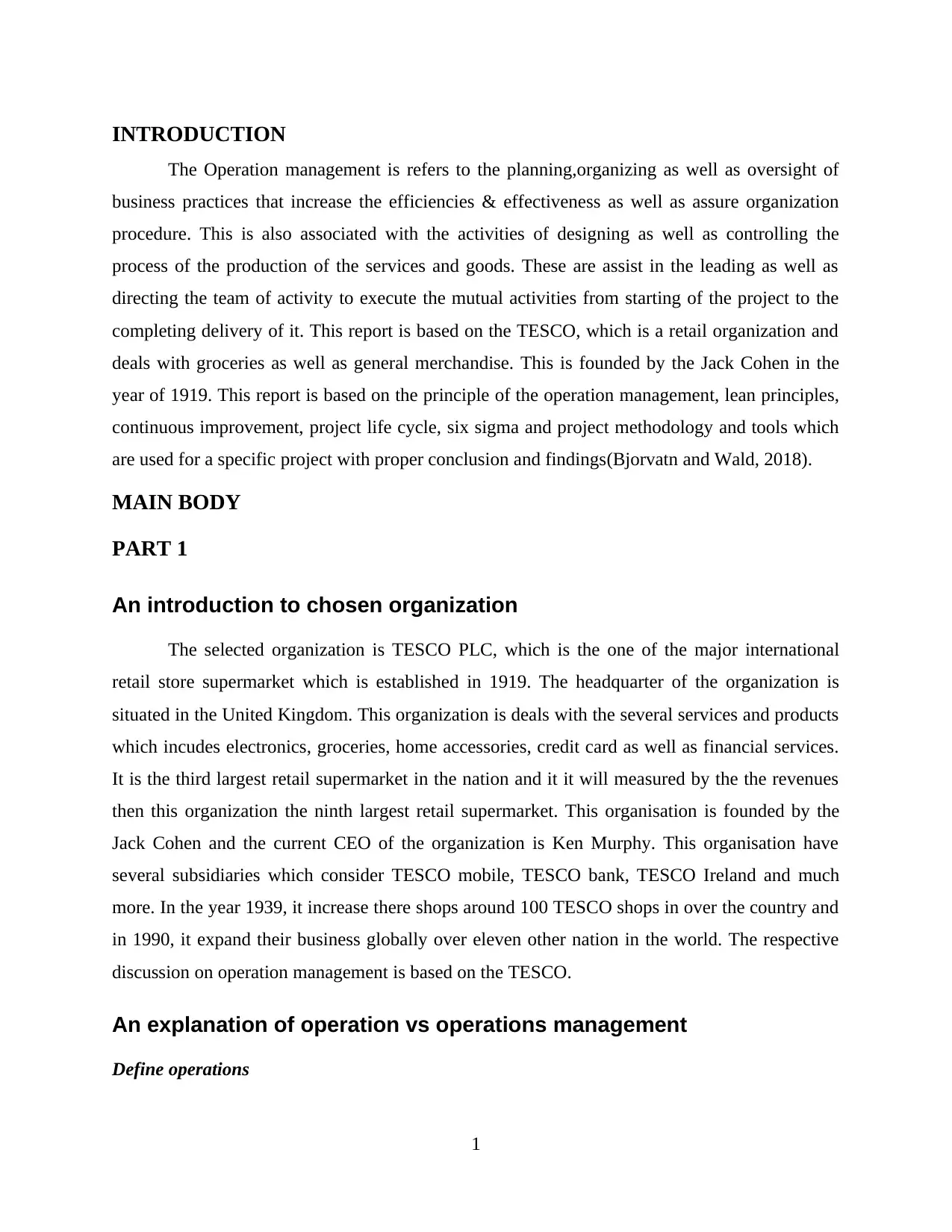
INTRODUCTION
The Operation management is refers to the planning,organizing as well as oversight of
business practices that increase the efficiencies & effectiveness as well as assure organization
procedure. This is also associated with the activities of designing as well as controlling the
process of the production of the services and goods. These are assist in the leading as well as
directing the team of activity to execute the mutual activities from starting of the project to the
completing delivery of it. This report is based on the TESCO, which is a retail organization and
deals with groceries as well as general merchandise. This is founded by the Jack Cohen in the
year of 1919. This report is based on the principle of the operation management, lean principles,
continuous improvement, project life cycle, six sigma and project methodology and tools which
are used for a specific project with proper conclusion and findings(Bjorvatn and Wald, 2018).
MAIN BODY
PART 1
An introduction to chosen organization
The selected organization is TESCO PLC, which is the one of the major international
retail store supermarket which is established in 1919. The headquarter of the organization is
situated in the United Kingdom. This organization is deals with the several services and products
which incudes electronics, groceries, home accessories, credit card as well as financial services.
It is the third largest retail supermarket in the nation and it it will measured by the the revenues
then this organization the ninth largest retail supermarket. This organisation is founded by the
Jack Cohen and the current CEO of the organization is Ken Murphy. This organisation have
several subsidiaries which consider TESCO mobile, TESCO bank, TESCO Ireland and much
more. In the year 1939, it increase there shops around 100 TESCO shops in over the country and
in 1990, it expand their business globally over eleven other nation in the world. The respective
discussion on operation management is based on the TESCO.
An explanation of operation vs operations management
Define operations
1
The Operation management is refers to the planning,organizing as well as oversight of
business practices that increase the efficiencies & effectiveness as well as assure organization
procedure. This is also associated with the activities of designing as well as controlling the
process of the production of the services and goods. These are assist in the leading as well as
directing the team of activity to execute the mutual activities from starting of the project to the
completing delivery of it. This report is based on the TESCO, which is a retail organization and
deals with groceries as well as general merchandise. This is founded by the Jack Cohen in the
year of 1919. This report is based on the principle of the operation management, lean principles,
continuous improvement, project life cycle, six sigma and project methodology and tools which
are used for a specific project with proper conclusion and findings(Bjorvatn and Wald, 2018).
MAIN BODY
PART 1
An introduction to chosen organization
The selected organization is TESCO PLC, which is the one of the major international
retail store supermarket which is established in 1919. The headquarter of the organization is
situated in the United Kingdom. This organization is deals with the several services and products
which incudes electronics, groceries, home accessories, credit card as well as financial services.
It is the third largest retail supermarket in the nation and it it will measured by the the revenues
then this organization the ninth largest retail supermarket. This organisation is founded by the
Jack Cohen and the current CEO of the organization is Ken Murphy. This organisation have
several subsidiaries which consider TESCO mobile, TESCO bank, TESCO Ireland and much
more. In the year 1939, it increase there shops around 100 TESCO shops in over the country and
in 1990, it expand their business globally over eleven other nation in the world. The respective
discussion on operation management is based on the TESCO.
An explanation of operation vs operations management
Define operations
1

Operations is a work of managing the inner working of the business so it runs as
efficiently as possible. This is the major function in an organization along with supply chain,
finance, human resourcing and marketing. This is the practical implementation if the some
process for make suitable actions form some practical work. It is the basic process of the
working of the task in a appropriate manner with the use of the particular methodologies
(Trimble, Murambiwa and Du Plessis, 2019).
Define Operations management
The operation management is refer to the execution of back end business functions such
as inventory, manufacturing as well as quality control of product to ensure market-ready
products as well as services. These are assist in the making of the greatest level of effectiveness
and efficiency for the organisation. It is obsessed as well as liable for the raw material into
service and product. These are also liable for the complete production of the product which is
consider logistic management and inventory control & some more.
Give examples how they apply to chosen organization
The operation and operation management is used by TESCO in the form of final delivery
of service and product to the buyers. These are use the several different principles of operation
and operation management which includes inventory control, total quality management and time
management. These principles are also use in the financial and credit card services for increasing
the effectiveness of the operation.
Implementation of operations management principles within
organization
Operations management process applied in chosen firm
There are several stages of the operations management which is used by the TESCO with
in the working premises. The first stage is refers to the planning process which is consider
feasibility study. There is second stage is includes the management and preparation of the
resources for execution. The third stage is refers to execution as well as supervising processes for
improved implementation of the task. The last and fourth stage is refer to the assessing process
which is essential for increasing profitability.
Strength:
2
efficiently as possible. This is the major function in an organization along with supply chain,
finance, human resourcing and marketing. This is the practical implementation if the some
process for make suitable actions form some practical work. It is the basic process of the
working of the task in a appropriate manner with the use of the particular methodologies
(Trimble, Murambiwa and Du Plessis, 2019).
Define Operations management
The operation management is refer to the execution of back end business functions such
as inventory, manufacturing as well as quality control of product to ensure market-ready
products as well as services. These are assist in the making of the greatest level of effectiveness
and efficiency for the organisation. It is obsessed as well as liable for the raw material into
service and product. These are also liable for the complete production of the product which is
consider logistic management and inventory control & some more.
Give examples how they apply to chosen organization
The operation and operation management is used by TESCO in the form of final delivery
of service and product to the buyers. These are use the several different principles of operation
and operation management which includes inventory control, total quality management and time
management. These principles are also use in the financial and credit card services for increasing
the effectiveness of the operation.
Implementation of operations management principles within
organization
Operations management process applied in chosen firm
There are several stages of the operations management which is used by the TESCO with
in the working premises. The first stage is refers to the planning process which is consider
feasibility study. There is second stage is includes the management and preparation of the
resources for execution. The third stage is refers to execution as well as supervising processes for
improved implementation of the task. The last and fourth stage is refer to the assessing process
which is essential for increasing profitability.
Strength:
2
Secure Best Marks with AI Grader
Need help grading? Try our AI Grader for instant feedback on your assignments.
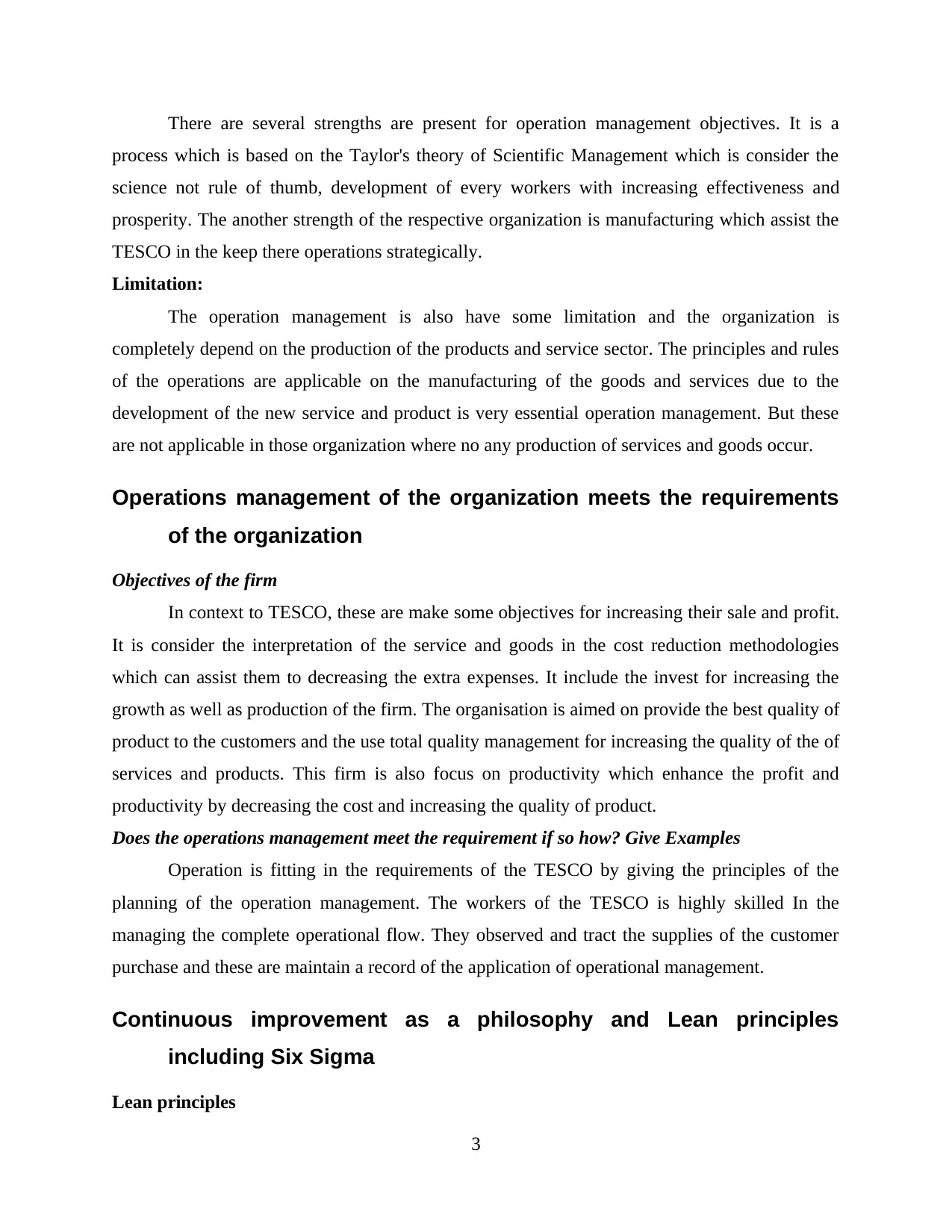
There are several strengths are present for operation management objectives. It is a
process which is based on the Taylor's theory of Scientific Management which is consider the
science not rule of thumb, development of every workers with increasing effectiveness and
prosperity. The another strength of the respective organization is manufacturing which assist the
TESCO in the keep there operations strategically.
Limitation:
The operation management is also have some limitation and the organization is
completely depend on the production of the products and service sector. The principles and rules
of the operations are applicable on the manufacturing of the goods and services due to the
development of the new service and product is very essential operation management. But these
are not applicable in those organization where no any production of services and goods occur.
Operations management of the organization meets the requirements
of the organization
Objectives of the firm
In context to TESCO, these are make some objectives for increasing their sale and profit.
It is consider the interpretation of the service and goods in the cost reduction methodologies
which can assist them to decreasing the extra expenses. It include the invest for increasing the
growth as well as production of the firm. The organisation is aimed on provide the best quality of
product to the customers and the use total quality management for increasing the quality of the of
services and products. This firm is also focus on productivity which enhance the profit and
productivity by decreasing the cost and increasing the quality of product.
Does the operations management meet the requirement if so how? Give Examples
Operation is fitting in the requirements of the TESCO by giving the principles of the
planning of the operation management. The workers of the TESCO is highly skilled In the
managing the complete operational flow. They observed and tract the supplies of the customer
purchase and these are maintain a record of the application of operational management.
Continuous improvement as a philosophy and Lean principles
including Six Sigma
Lean principles
3
process which is based on the Taylor's theory of Scientific Management which is consider the
science not rule of thumb, development of every workers with increasing effectiveness and
prosperity. The another strength of the respective organization is manufacturing which assist the
TESCO in the keep there operations strategically.
Limitation:
The operation management is also have some limitation and the organization is
completely depend on the production of the products and service sector. The principles and rules
of the operations are applicable on the manufacturing of the goods and services due to the
development of the new service and product is very essential operation management. But these
are not applicable in those organization where no any production of services and goods occur.
Operations management of the organization meets the requirements
of the organization
Objectives of the firm
In context to TESCO, these are make some objectives for increasing their sale and profit.
It is consider the interpretation of the service and goods in the cost reduction methodologies
which can assist them to decreasing the extra expenses. It include the invest for increasing the
growth as well as production of the firm. The organisation is aimed on provide the best quality of
product to the customers and the use total quality management for increasing the quality of the of
services and products. This firm is also focus on productivity which enhance the profit and
productivity by decreasing the cost and increasing the quality of product.
Does the operations management meet the requirement if so how? Give Examples
Operation is fitting in the requirements of the TESCO by giving the principles of the
planning of the operation management. The workers of the TESCO is highly skilled In the
managing the complete operational flow. They observed and tract the supplies of the customer
purchase and these are maintain a record of the application of operational management.
Continuous improvement as a philosophy and Lean principles
including Six Sigma
Lean principles
3

The lean principle is a business strategies driven by the principle of doing more with less.
These are targeted on decreasing the wastage or resourcing at the time of manufacturing of the
services and products in the working premises. These are based on the some principles which are
used by the TESCO. These are mentioned as:
Value defining: The respective organization TESCO is aimed on giving the best quality
of the goods to the buyers. These are supply the products according to the requirements of the
customers.
Mapping of value stream: This principle is identifying as well as mapping the value
stream. The main aim of this is to use the customer's values as a reference point and identify all
the activities that contribute to these value. The TESCO is aimed on develop the knowing about
the aspect which are helpful in creating eliminating and creating factor which are not important
to them.
Creating flow: The TESCO is use their materials, resources and labor in attaining the
objective and goals of the firm. These are also assisting in the increasing the performance of the
organization and workers. These are also provide some training for learning new skills as well as
knowledge.
Pull establishment: The aim of this principle is to limit inventory and work in process
item while ensuring that the requisite material and information are available for a smooth flow of
work. In Context to TESCO, these are aimed on managing the inventory for supply the best
quality of products.
Methods of lean production:
The Kaizen is a method of the lean production and it is compound of two Japanese word
that together translate good change or improvement. These are associated with the improvement
of the productivity by the use of the methodical as well as gradual process. This is a method of
the lean production which is explained the time saving and time efficiencies methodologies in
operational management. There are Kanban is also a one of the best method for lean production.
This method is associated with the elimination of the inventory shortage and increasing the
operations by visuals. There are Andon is also a method of lean production which notifies
managerial, maintenance and other worker of quality or process problem (Andrejić and
Mirčevski, 2020).
Which ones does chosen firm apply?
4
These are targeted on decreasing the wastage or resourcing at the time of manufacturing of the
services and products in the working premises. These are based on the some principles which are
used by the TESCO. These are mentioned as:
Value defining: The respective organization TESCO is aimed on giving the best quality
of the goods to the buyers. These are supply the products according to the requirements of the
customers.
Mapping of value stream: This principle is identifying as well as mapping the value
stream. The main aim of this is to use the customer's values as a reference point and identify all
the activities that contribute to these value. The TESCO is aimed on develop the knowing about
the aspect which are helpful in creating eliminating and creating factor which are not important
to them.
Creating flow: The TESCO is use their materials, resources and labor in attaining the
objective and goals of the firm. These are also assisting in the increasing the performance of the
organization and workers. These are also provide some training for learning new skills as well as
knowledge.
Pull establishment: The aim of this principle is to limit inventory and work in process
item while ensuring that the requisite material and information are available for a smooth flow of
work. In Context to TESCO, these are aimed on managing the inventory for supply the best
quality of products.
Methods of lean production:
The Kaizen is a method of the lean production and it is compound of two Japanese word
that together translate good change or improvement. These are associated with the improvement
of the productivity by the use of the methodical as well as gradual process. This is a method of
the lean production which is explained the time saving and time efficiencies methodologies in
operational management. There are Kanban is also a one of the best method for lean production.
This method is associated with the elimination of the inventory shortage and increasing the
operations by visuals. There are Andon is also a method of lean production which notifies
managerial, maintenance and other worker of quality or process problem (Andrejić and
Mirčevski, 2020).
Which ones does chosen firm apply?
4
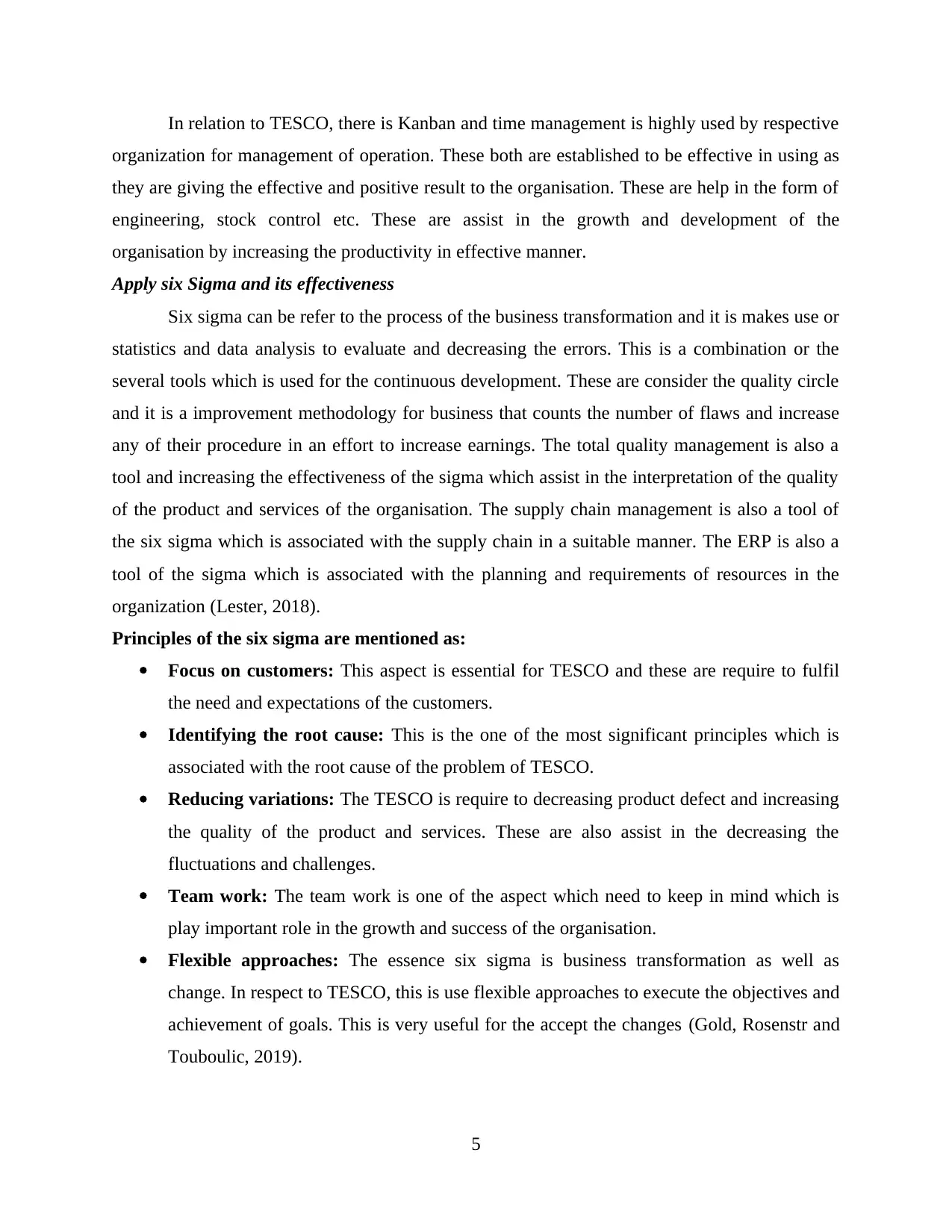
In relation to TESCO, there is Kanban and time management is highly used by respective
organization for management of operation. These both are established to be effective in using as
they are giving the effective and positive result to the organisation. These are help in the form of
engineering, stock control etc. These are assist in the growth and development of the
organisation by increasing the productivity in effective manner.
Apply six Sigma and its effectiveness
Six sigma can be refer to the process of the business transformation and it is makes use or
statistics and data analysis to evaluate and decreasing the errors. This is a combination or the
several tools which is used for the continuous development. These are consider the quality circle
and it is a improvement methodology for business that counts the number of flaws and increase
any of their procedure in an effort to increase earnings. The total quality management is also a
tool and increasing the effectiveness of the sigma which assist in the interpretation of the quality
of the product and services of the organisation. The supply chain management is also a tool of
the six sigma which is associated with the supply chain in a suitable manner. The ERP is also a
tool of the sigma which is associated with the planning and requirements of resources in the
organization (Lester, 2018).
Principles of the six sigma are mentioned as:
Focus on customers: This aspect is essential for TESCO and these are require to fulfil
the need and expectations of the customers.
Identifying the root cause: This is the one of the most significant principles which is
associated with the root cause of the problem of TESCO.
Reducing variations: The TESCO is require to decreasing product defect and increasing
the quality of the product and services. These are also assist in the decreasing the
fluctuations and challenges.
Team work: The team work is one of the aspect which need to keep in mind which is
play important role in the growth and success of the organisation.
Flexible approaches: The essence six sigma is business transformation as well as
change. In respect to TESCO, this is use flexible approaches to execute the objectives and
achievement of goals. This is very useful for the accept the changes (Gold, Rosenstr and
Touboulic, 2019).
5
organization for management of operation. These both are established to be effective in using as
they are giving the effective and positive result to the organisation. These are help in the form of
engineering, stock control etc. These are assist in the growth and development of the
organisation by increasing the productivity in effective manner.
Apply six Sigma and its effectiveness
Six sigma can be refer to the process of the business transformation and it is makes use or
statistics and data analysis to evaluate and decreasing the errors. This is a combination or the
several tools which is used for the continuous development. These are consider the quality circle
and it is a improvement methodology for business that counts the number of flaws and increase
any of their procedure in an effort to increase earnings. The total quality management is also a
tool and increasing the effectiveness of the sigma which assist in the interpretation of the quality
of the product and services of the organisation. The supply chain management is also a tool of
the six sigma which is associated with the supply chain in a suitable manner. The ERP is also a
tool of the sigma which is associated with the planning and requirements of resources in the
organization (Lester, 2018).
Principles of the six sigma are mentioned as:
Focus on customers: This aspect is essential for TESCO and these are require to fulfil
the need and expectations of the customers.
Identifying the root cause: This is the one of the most significant principles which is
associated with the root cause of the problem of TESCO.
Reducing variations: The TESCO is require to decreasing product defect and increasing
the quality of the product and services. These are also assist in the decreasing the
fluctuations and challenges.
Team work: The team work is one of the aspect which need to keep in mind which is
play important role in the growth and success of the organisation.
Flexible approaches: The essence six sigma is business transformation as well as
change. In respect to TESCO, this is use flexible approaches to execute the objectives and
achievement of goals. This is very useful for the accept the changes (Gold, Rosenstr and
Touboulic, 2019).
5
Paraphrase This Document
Need a fresh take? Get an instant paraphrase of this document with our AI Paraphraser
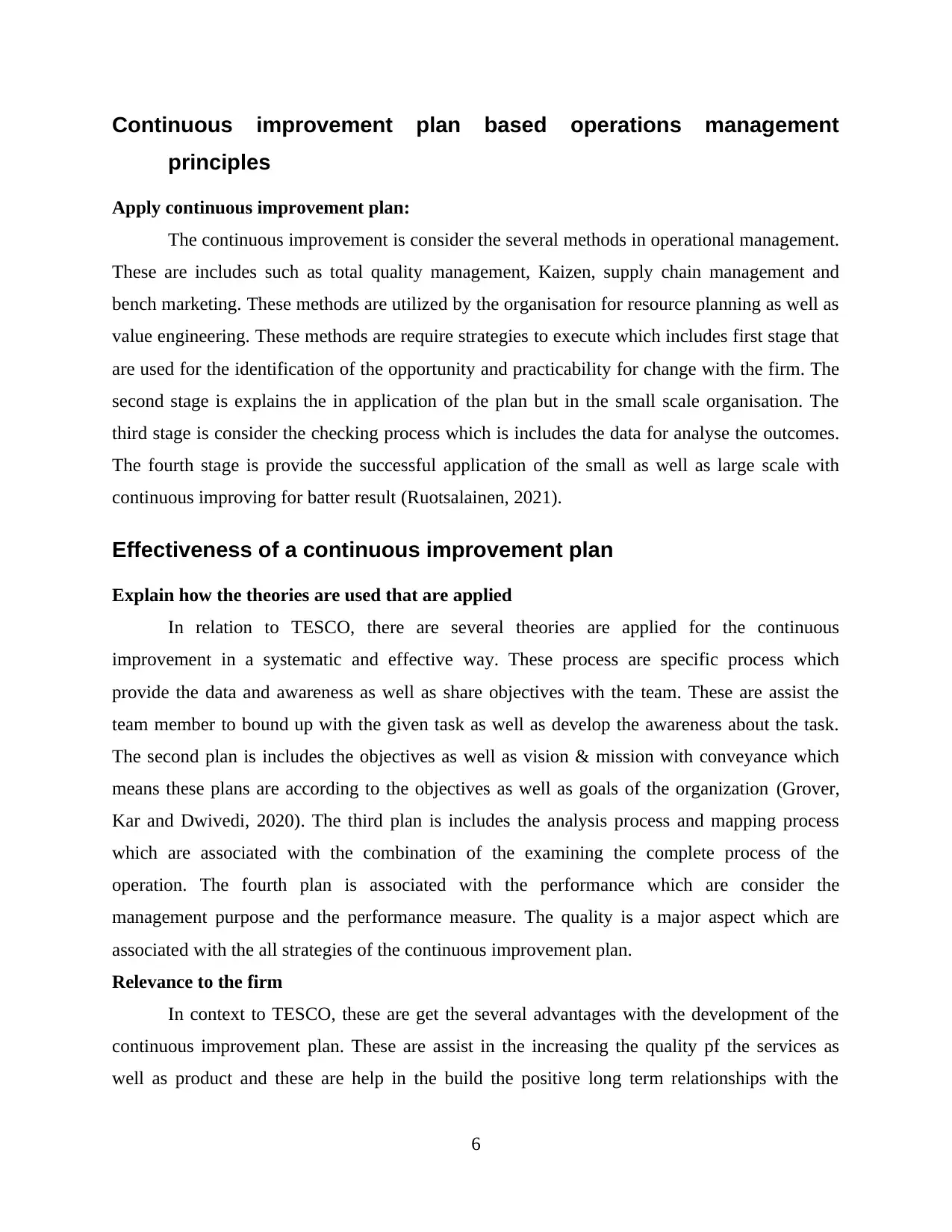
Continuous improvement plan based operations management
principles
Apply continuous improvement plan:
The continuous improvement is consider the several methods in operational management.
These are includes such as total quality management, Kaizen, supply chain management and
bench marketing. These methods are utilized by the organisation for resource planning as well as
value engineering. These methods are require strategies to execute which includes first stage that
are used for the identification of the opportunity and practicability for change with the firm. The
second stage is explains the in application of the plan but in the small scale organisation. The
third stage is consider the checking process which is includes the data for analyse the outcomes.
The fourth stage is provide the successful application of the small as well as large scale with
continuous improving for batter result (Ruotsalainen, 2021).
Effectiveness of a continuous improvement plan
Explain how the theories are used that are applied
In relation to TESCO, there are several theories are applied for the continuous
improvement in a systematic and effective way. These process are specific process which
provide the data and awareness as well as share objectives with the team. These are assist the
team member to bound up with the given task as well as develop the awareness about the task.
The second plan is includes the objectives as well as vision & mission with conveyance which
means these plans are according to the objectives as well as goals of the organization (Grover,
Kar and Dwivedi, 2020). The third plan is includes the analysis process and mapping process
which are associated with the combination of the examining the complete process of the
operation. The fourth plan is associated with the performance which are consider the
management purpose and the performance measure. The quality is a major aspect which are
associated with the all strategies of the continuous improvement plan.
Relevance to the firm
In context to TESCO, these are get the several advantages with the development of the
continuous improvement plan. These are assist in the increasing the quality pf the services as
well as product and these are help in the build the positive long term relationships with the
6
principles
Apply continuous improvement plan:
The continuous improvement is consider the several methods in operational management.
These are includes such as total quality management, Kaizen, supply chain management and
bench marketing. These methods are utilized by the organisation for resource planning as well as
value engineering. These methods are require strategies to execute which includes first stage that
are used for the identification of the opportunity and practicability for change with the firm. The
second stage is explains the in application of the plan but in the small scale organisation. The
third stage is consider the checking process which is includes the data for analyse the outcomes.
The fourth stage is provide the successful application of the small as well as large scale with
continuous improving for batter result (Ruotsalainen, 2021).
Effectiveness of a continuous improvement plan
Explain how the theories are used that are applied
In relation to TESCO, there are several theories are applied for the continuous
improvement in a systematic and effective way. These process are specific process which
provide the data and awareness as well as share objectives with the team. These are assist the
team member to bound up with the given task as well as develop the awareness about the task.
The second plan is includes the objectives as well as vision & mission with conveyance which
means these plans are according to the objectives as well as goals of the organization (Grover,
Kar and Dwivedi, 2020). The third plan is includes the analysis process and mapping process
which are associated with the combination of the examining the complete process of the
operation. The fourth plan is associated with the performance which are consider the
management purpose and the performance measure. The quality is a major aspect which are
associated with the all strategies of the continuous improvement plan.
Relevance to the firm
In context to TESCO, these are get the several advantages with the development of the
continuous improvement plan. These are assist in the increasing the quality pf the services as
well as product and these are help in the build the positive long term relationships with the
6
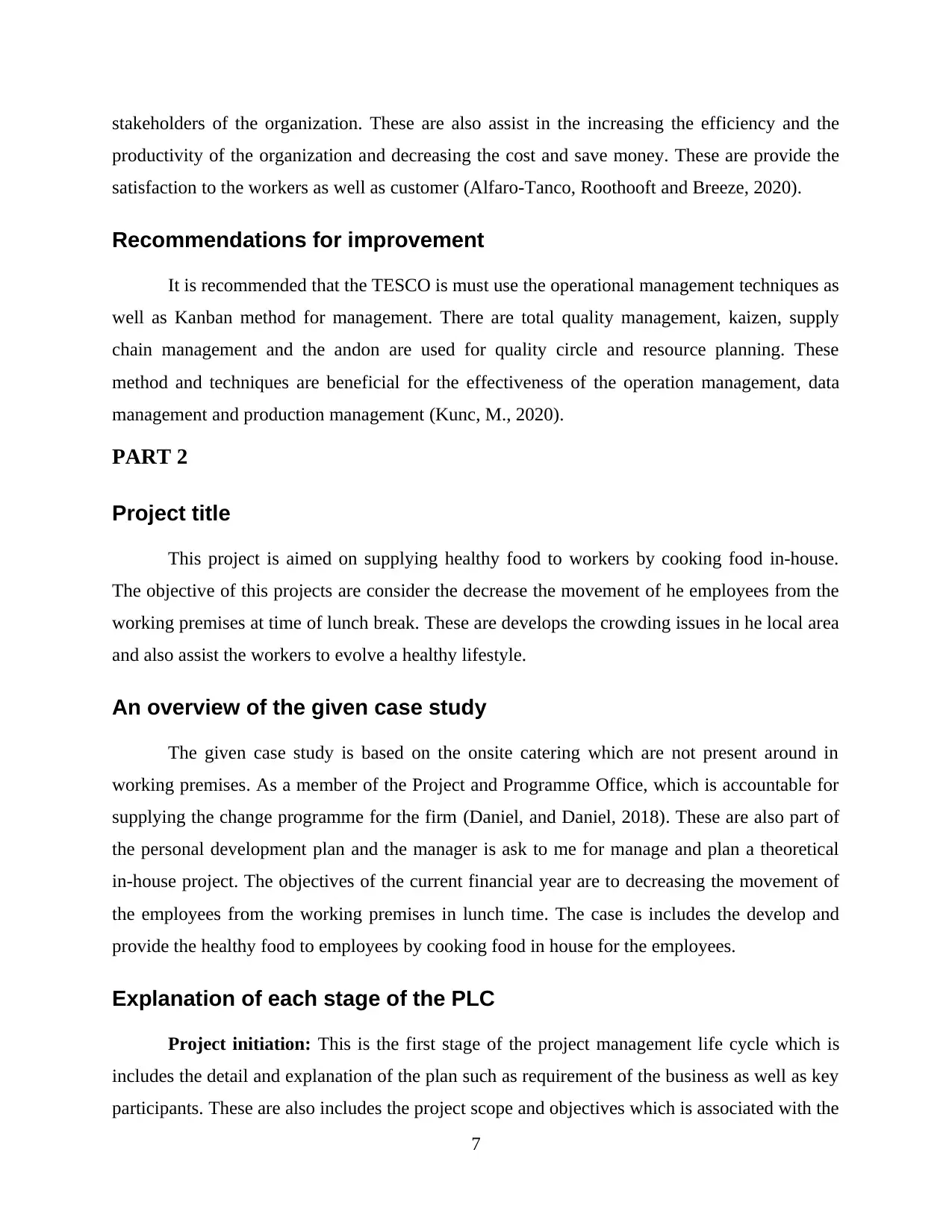
stakeholders of the organization. These are also assist in the increasing the efficiency and the
productivity of the organization and decreasing the cost and save money. These are provide the
satisfaction to the workers as well as customer (Alfaro-Tanco, Roothooft and Breeze, 2020).
Recommendations for improvement
It is recommended that the TESCO is must use the operational management techniques as
well as Kanban method for management. There are total quality management, kaizen, supply
chain management and the andon are used for quality circle and resource planning. These
method and techniques are beneficial for the effectiveness of the operation management, data
management and production management (Kunc, M., 2020).
PART 2
Project title
This project is aimed on supplying healthy food to workers by cooking food in-house.
The objective of this projects are consider the decrease the movement of he employees from the
working premises at time of lunch break. These are develops the crowding issues in he local area
and also assist the workers to evolve a healthy lifestyle.
An overview of the given case study
The given case study is based on the onsite catering which are not present around in
working premises. As a member of the Project and Programme Office, which is accountable for
supplying the change programme for the firm (Daniel, and Daniel, 2018). These are also part of
the personal development plan and the manager is ask to me for manage and plan a theoretical
in-house project. The objectives of the current financial year are to decreasing the movement of
the employees from the working premises in lunch time. The case is includes the develop and
provide the healthy food to employees by cooking food in house for the employees.
Explanation of each stage of the PLC
Project initiation: This is the first stage of the project management life cycle which is
includes the detail and explanation of the plan such as requirement of the business as well as key
participants. These are also includes the project scope and objectives which is associated with the
7
productivity of the organization and decreasing the cost and save money. These are provide the
satisfaction to the workers as well as customer (Alfaro-Tanco, Roothooft and Breeze, 2020).
Recommendations for improvement
It is recommended that the TESCO is must use the operational management techniques as
well as Kanban method for management. There are total quality management, kaizen, supply
chain management and the andon are used for quality circle and resource planning. These
method and techniques are beneficial for the effectiveness of the operation management, data
management and production management (Kunc, M., 2020).
PART 2
Project title
This project is aimed on supplying healthy food to workers by cooking food in-house.
The objective of this projects are consider the decrease the movement of he employees from the
working premises at time of lunch break. These are develops the crowding issues in he local area
and also assist the workers to evolve a healthy lifestyle.
An overview of the given case study
The given case study is based on the onsite catering which are not present around in
working premises. As a member of the Project and Programme Office, which is accountable for
supplying the change programme for the firm (Daniel, and Daniel, 2018). These are also part of
the personal development plan and the manager is ask to me for manage and plan a theoretical
in-house project. The objectives of the current financial year are to decreasing the movement of
the employees from the working premises in lunch time. The case is includes the develop and
provide the healthy food to employees by cooking food in house for the employees.
Explanation of each stage of the PLC
Project initiation: This is the first stage of the project management life cycle which is
includes the detail and explanation of the plan such as requirement of the business as well as key
participants. These are also includes the project scope and objectives which is associated with the
7
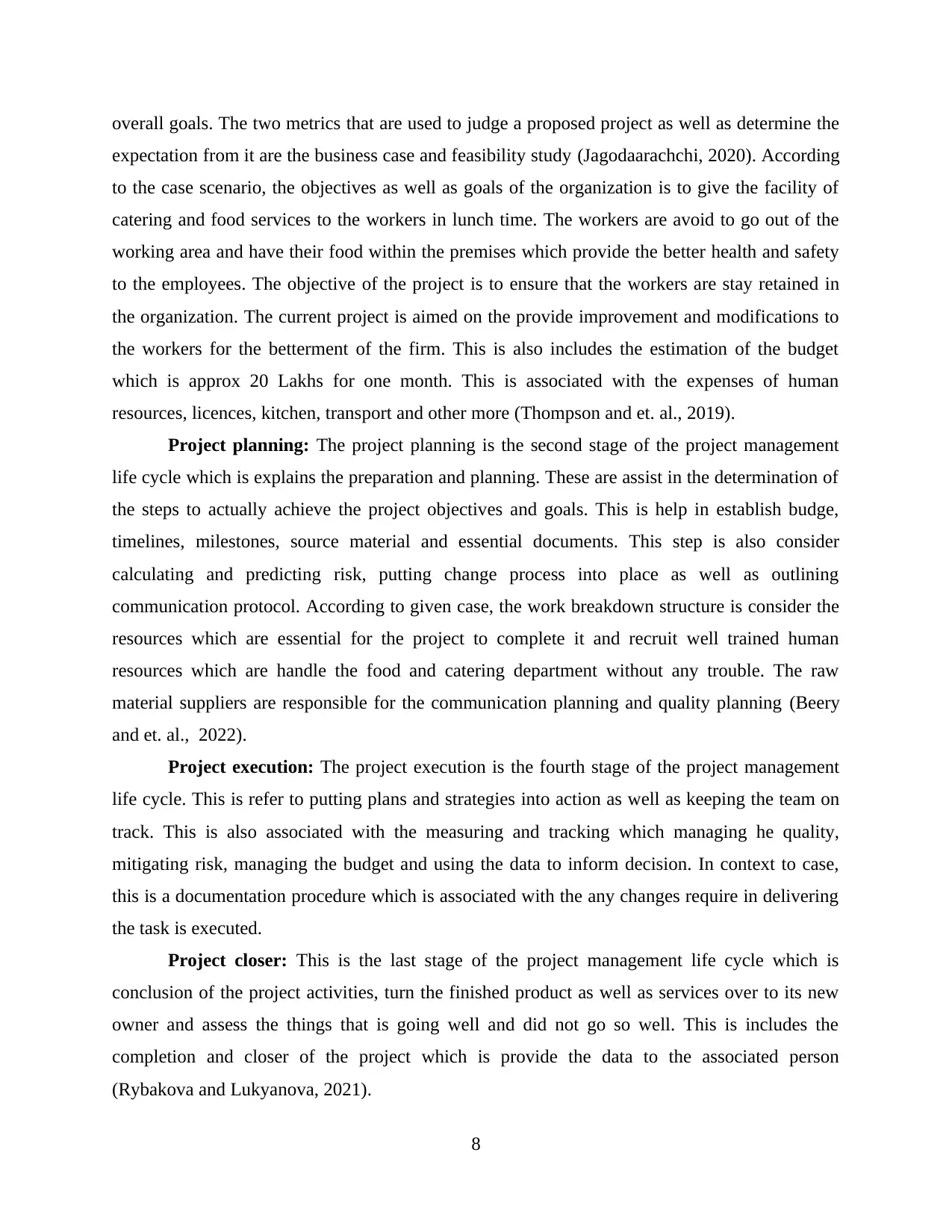
overall goals. The two metrics that are used to judge a proposed project as well as determine the
expectation from it are the business case and feasibility study (Jagodaarachchi, 2020). According
to the case scenario, the objectives as well as goals of the organization is to give the facility of
catering and food services to the workers in lunch time. The workers are avoid to go out of the
working area and have their food within the premises which provide the better health and safety
to the employees. The objective of the project is to ensure that the workers are stay retained in
the organization. The current project is aimed on the provide improvement and modifications to
the workers for the betterment of the firm. This is also includes the estimation of the budget
which is approx 20 Lakhs for one month. This is associated with the expenses of human
resources, licences, kitchen, transport and other more (Thompson and et. al., 2019).
Project planning: The project planning is the second stage of the project management
life cycle which is explains the preparation and planning. These are assist in the determination of
the steps to actually achieve the project objectives and goals. This is help in establish budge,
timelines, milestones, source material and essential documents. This step is also consider
calculating and predicting risk, putting change process into place as well as outlining
communication protocol. According to given case, the work breakdown structure is consider the
resources which are essential for the project to complete it and recruit well trained human
resources which are handle the food and catering department without any trouble. The raw
material suppliers are responsible for the communication planning and quality planning (Beery
and et. al., 2022).
Project execution: The project execution is the fourth stage of the project management
life cycle. This is refer to putting plans and strategies into action as well as keeping the team on
track. This is also associated with the measuring and tracking which managing he quality,
mitigating risk, managing the budget and using the data to inform decision. In context to case,
this is a documentation procedure which is associated with the any changes require in delivering
the task is executed.
Project closer: This is the last stage of the project management life cycle which is
conclusion of the project activities, turn the finished product as well as services over to its new
owner and assess the things that is going well and did not go so well. This is includes the
completion and closer of the project which is provide the data to the associated person
(Rybakova and Lukyanova, 2021).
8
expectation from it are the business case and feasibility study (Jagodaarachchi, 2020). According
to the case scenario, the objectives as well as goals of the organization is to give the facility of
catering and food services to the workers in lunch time. The workers are avoid to go out of the
working area and have their food within the premises which provide the better health and safety
to the employees. The objective of the project is to ensure that the workers are stay retained in
the organization. The current project is aimed on the provide improvement and modifications to
the workers for the betterment of the firm. This is also includes the estimation of the budget
which is approx 20 Lakhs for one month. This is associated with the expenses of human
resources, licences, kitchen, transport and other more (Thompson and et. al., 2019).
Project planning: The project planning is the second stage of the project management
life cycle which is explains the preparation and planning. These are assist in the determination of
the steps to actually achieve the project objectives and goals. This is help in establish budge,
timelines, milestones, source material and essential documents. This step is also consider
calculating and predicting risk, putting change process into place as well as outlining
communication protocol. According to given case, the work breakdown structure is consider the
resources which are essential for the project to complete it and recruit well trained human
resources which are handle the food and catering department without any trouble. The raw
material suppliers are responsible for the communication planning and quality planning (Beery
and et. al., 2022).
Project execution: The project execution is the fourth stage of the project management
life cycle. This is refer to putting plans and strategies into action as well as keeping the team on
track. This is also associated with the measuring and tracking which managing he quality,
mitigating risk, managing the budget and using the data to inform decision. In context to case,
this is a documentation procedure which is associated with the any changes require in delivering
the task is executed.
Project closer: This is the last stage of the project management life cycle which is
conclusion of the project activities, turn the finished product as well as services over to its new
owner and assess the things that is going well and did not go so well. This is includes the
completion and closer of the project which is provide the data to the associated person
(Rybakova and Lukyanova, 2021).
8
Secure Best Marks with AI Grader
Need help grading? Try our AI Grader for instant feedback on your assignments.
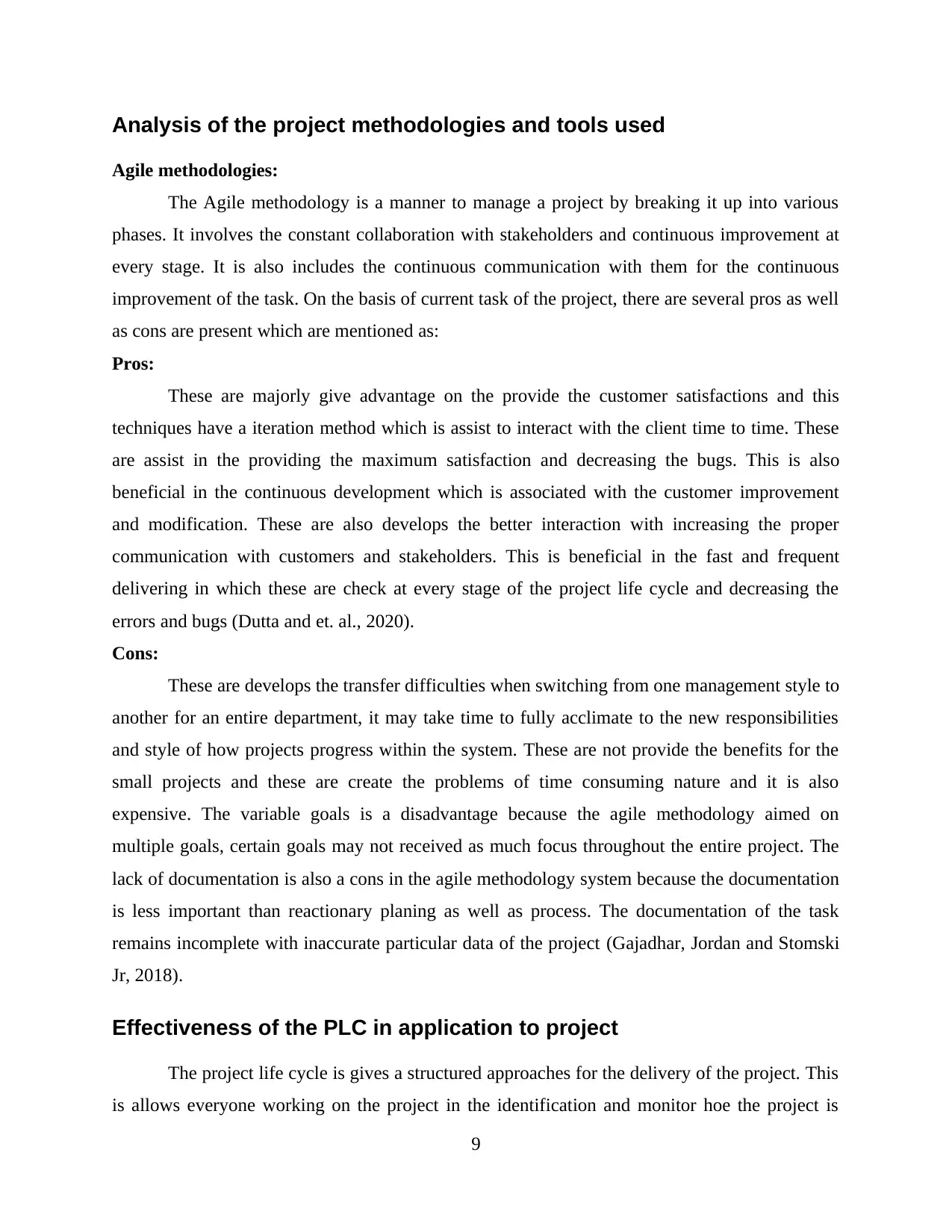
Analysis of the project methodologies and tools used
Agile methodologies:
The Agile methodology is a manner to manage a project by breaking it up into various
phases. It involves the constant collaboration with stakeholders and continuous improvement at
every stage. It is also includes the continuous communication with them for the continuous
improvement of the task. On the basis of current task of the project, there are several pros as well
as cons are present which are mentioned as:
Pros:
These are majorly give advantage on the provide the customer satisfactions and this
techniques have a iteration method which is assist to interact with the client time to time. These
are assist in the providing the maximum satisfaction and decreasing the bugs. This is also
beneficial in the continuous development which is associated with the customer improvement
and modification. These are also develops the better interaction with increasing the proper
communication with customers and stakeholders. This is beneficial in the fast and frequent
delivering in which these are check at every stage of the project life cycle and decreasing the
errors and bugs (Dutta and et. al., 2020).
Cons:
These are develops the transfer difficulties when switching from one management style to
another for an entire department, it may take time to fully acclimate to the new responsibilities
and style of how projects progress within the system. These are not provide the benefits for the
small projects and these are create the problems of time consuming nature and it is also
expensive. The variable goals is a disadvantage because the agile methodology aimed on
multiple goals, certain goals may not received as much focus throughout the entire project. The
lack of documentation is also a cons in the agile methodology system because the documentation
is less important than reactionary planing as well as process. The documentation of the task
remains incomplete with inaccurate particular data of the project (Gajadhar, Jordan and Stomski
Jr, 2018).
Effectiveness of the PLC in application to project
The project life cycle is gives a structured approaches for the delivery of the project. This
is allows everyone working on the project in the identification and monitor hoe the project is
9
Agile methodologies:
The Agile methodology is a manner to manage a project by breaking it up into various
phases. It involves the constant collaboration with stakeholders and continuous improvement at
every stage. It is also includes the continuous communication with them for the continuous
improvement of the task. On the basis of current task of the project, there are several pros as well
as cons are present which are mentioned as:
Pros:
These are majorly give advantage on the provide the customer satisfactions and this
techniques have a iteration method which is assist to interact with the client time to time. These
are assist in the providing the maximum satisfaction and decreasing the bugs. This is also
beneficial in the continuous development which is associated with the customer improvement
and modification. These are also develops the better interaction with increasing the proper
communication with customers and stakeholders. This is beneficial in the fast and frequent
delivering in which these are check at every stage of the project life cycle and decreasing the
errors and bugs (Dutta and et. al., 2020).
Cons:
These are develops the transfer difficulties when switching from one management style to
another for an entire department, it may take time to fully acclimate to the new responsibilities
and style of how projects progress within the system. These are not provide the benefits for the
small projects and these are create the problems of time consuming nature and it is also
expensive. The variable goals is a disadvantage because the agile methodology aimed on
multiple goals, certain goals may not received as much focus throughout the entire project. The
lack of documentation is also a cons in the agile methodology system because the documentation
is less important than reactionary planing as well as process. The documentation of the task
remains incomplete with inaccurate particular data of the project (Gajadhar, Jordan and Stomski
Jr, 2018).
Effectiveness of the PLC in application to project
The project life cycle is gives a structured approaches for the delivery of the project. This
is allows everyone working on the project in the identification and monitor hoe the project is
9
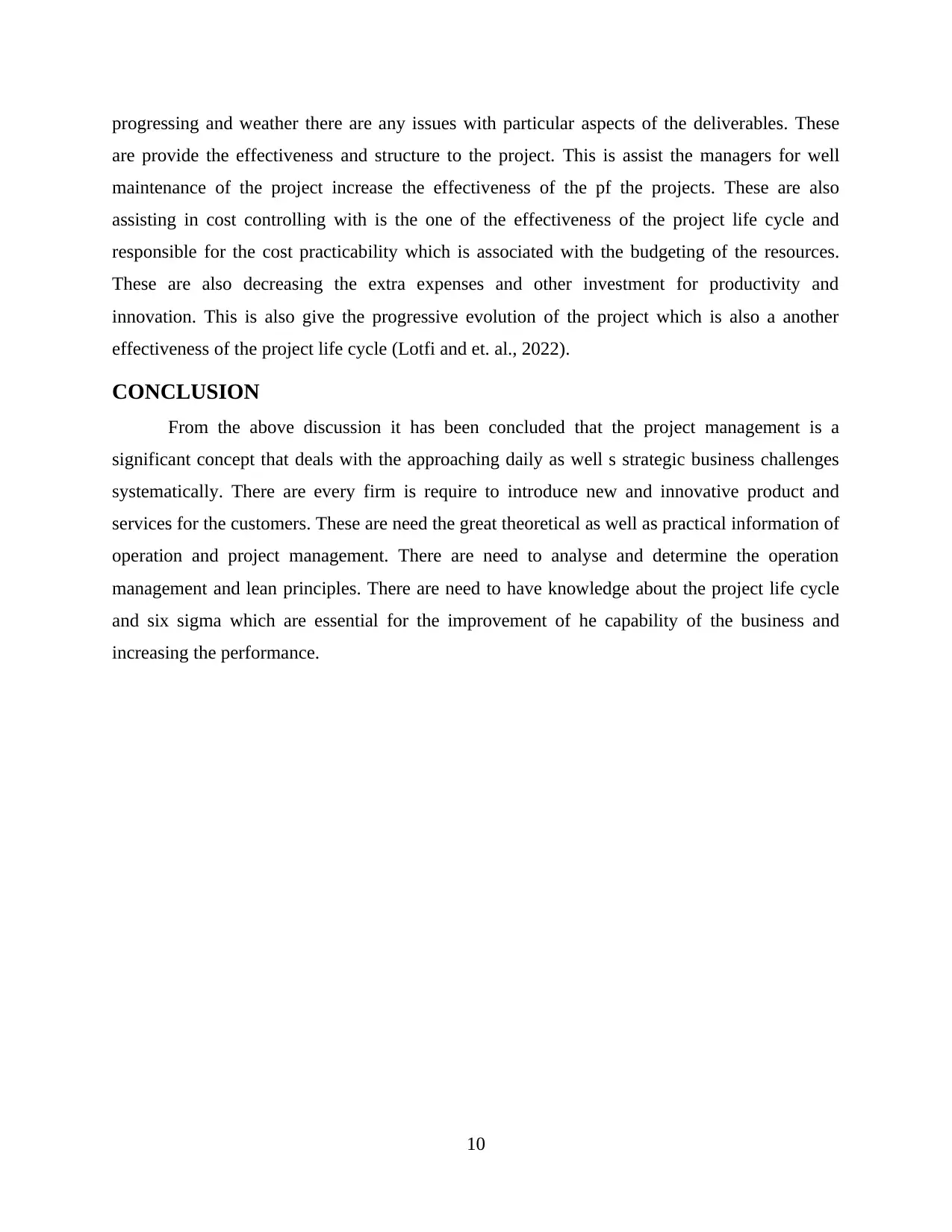
progressing and weather there are any issues with particular aspects of the deliverables. These
are provide the effectiveness and structure to the project. This is assist the managers for well
maintenance of the project increase the effectiveness of the pf the projects. These are also
assisting in cost controlling with is the one of the effectiveness of the project life cycle and
responsible for the cost practicability which is associated with the budgeting of the resources.
These are also decreasing the extra expenses and other investment for productivity and
innovation. This is also give the progressive evolution of the project which is also a another
effectiveness of the project life cycle (Lotfi and et. al., 2022).
CONCLUSION
From the above discussion it has been concluded that the project management is a
significant concept that deals with the approaching daily as well s strategic business challenges
systematically. There are every firm is require to introduce new and innovative product and
services for the customers. These are need the great theoretical as well as practical information of
operation and project management. There are need to analyse and determine the operation
management and lean principles. There are need to have knowledge about the project life cycle
and six sigma which are essential for the improvement of he capability of the business and
increasing the performance.
10
are provide the effectiveness and structure to the project. This is assist the managers for well
maintenance of the project increase the effectiveness of the pf the projects. These are also
assisting in cost controlling with is the one of the effectiveness of the project life cycle and
responsible for the cost practicability which is associated with the budgeting of the resources.
These are also decreasing the extra expenses and other investment for productivity and
innovation. This is also give the progressive evolution of the project which is also a another
effectiveness of the project life cycle (Lotfi and et. al., 2022).
CONCLUSION
From the above discussion it has been concluded that the project management is a
significant concept that deals with the approaching daily as well s strategic business challenges
systematically. There are every firm is require to introduce new and innovative product and
services for the customers. These are need the great theoretical as well as practical information of
operation and project management. There are need to analyse and determine the operation
management and lean principles. There are need to have knowledge about the project life cycle
and six sigma which are essential for the improvement of he capability of the business and
increasing the performance.
10
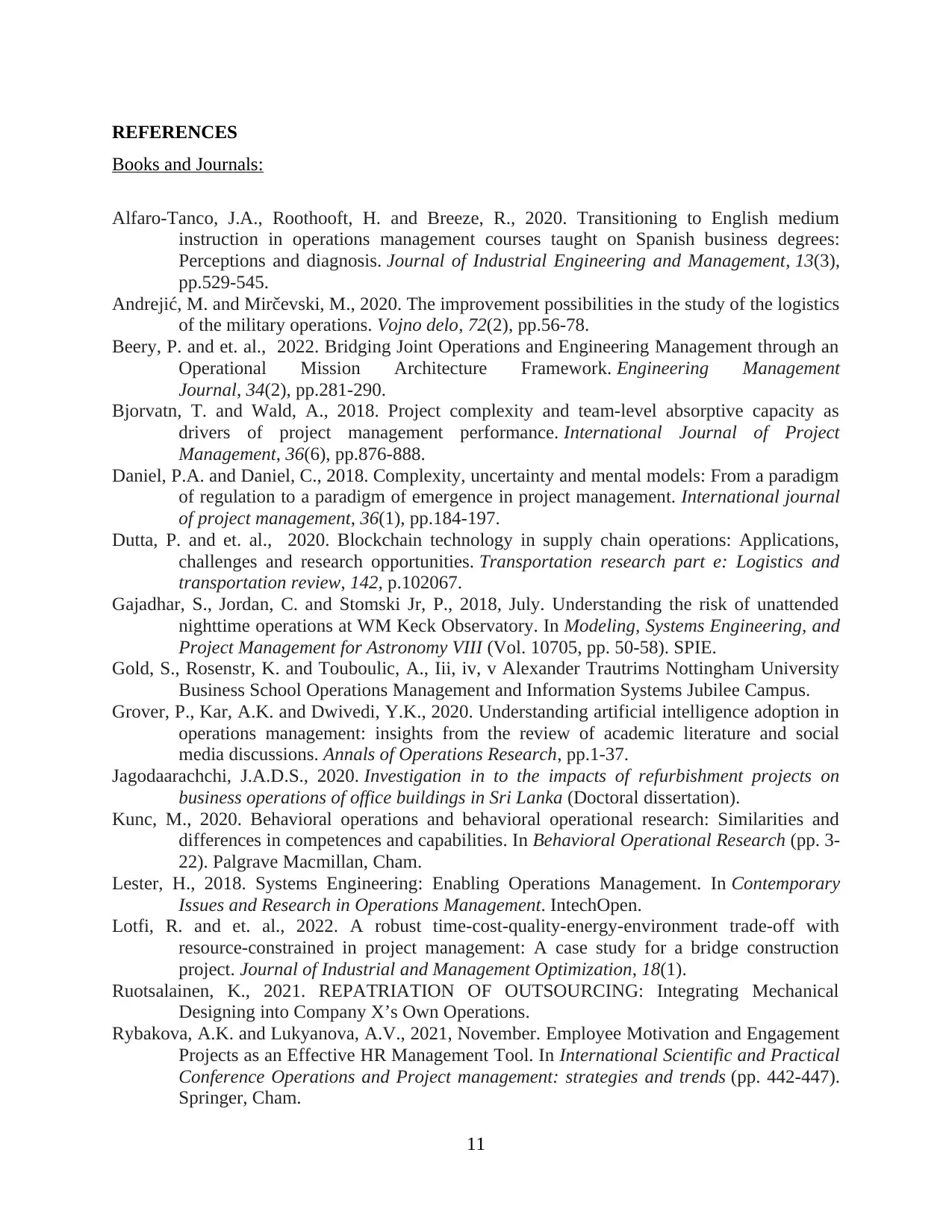
REFERENCES
Books and Journals:
Alfaro-Tanco, J.A., Roothooft, H. and Breeze, R., 2020. Transitioning to English medium
instruction in operations management courses taught on Spanish business degrees:
Perceptions and diagnosis. Journal of Industrial Engineering and Management, 13(3),
pp.529-545.
Andrejić, M. and Mirčevski, M., 2020. The improvement possibilities in the study of the logistics
of the military operations. Vojno delo, 72(2), pp.56-78.
Beery, P. and et. al., 2022. Bridging Joint Operations and Engineering Management through an
Operational Mission Architecture Framework. Engineering Management
Journal, 34(2), pp.281-290.
Bjorvatn, T. and Wald, A., 2018. Project complexity and team-level absorptive capacity as
drivers of project management performance. International Journal of Project
Management, 36(6), pp.876-888.
Daniel, P.A. and Daniel, C., 2018. Complexity, uncertainty and mental models: From a paradigm
of regulation to a paradigm of emergence in project management. International journal
of project management, 36(1), pp.184-197.
Dutta, P. and et. al., 2020. Blockchain technology in supply chain operations: Applications,
challenges and research opportunities. Transportation research part e: Logistics and
transportation review, 142, p.102067.
Gajadhar, S., Jordan, C. and Stomski Jr, P., 2018, July. Understanding the risk of unattended
nighttime operations at WM Keck Observatory. In Modeling, Systems Engineering, and
Project Management for Astronomy VIII (Vol. 10705, pp. 50-58). SPIE.
Gold, S., Rosenstr, K. and Touboulic, A., Iii, iv, v Alexander Trautrims Nottingham University
Business School Operations Management and Information Systems Jubilee Campus.
Grover, P., Kar, A.K. and Dwivedi, Y.K., 2020. Understanding artificial intelligence adoption in
operations management: insights from the review of academic literature and social
media discussions. Annals of Operations Research, pp.1-37.
Jagodaarachchi, J.A.D.S., 2020. Investigation in to the impacts of refurbishment projects on
business operations of office buildings in Sri Lanka (Doctoral dissertation).
Kunc, M., 2020. Behavioral operations and behavioral operational research: Similarities and
differences in competences and capabilities. In Behavioral Operational Research (pp. 3-
22). Palgrave Macmillan, Cham.
Lester, H., 2018. Systems Engineering: Enabling Operations Management. In Contemporary
Issues and Research in Operations Management. IntechOpen.
Lotfi, R. and et. al., 2022. A robust time-cost-quality-energy-environment trade-off with
resource-constrained in project management: A case study for a bridge construction
project. Journal of Industrial and Management Optimization, 18(1).
Ruotsalainen, K., 2021. REPATRIATION OF OUTSOURCING: Integrating Mechanical
Designing into Company X’s Own Operations.
Rybakova, A.K. and Lukyanova, A.V., 2021, November. Employee Motivation and Engagement
Projects as an Effective HR Management Tool. In International Scientific and Practical
Conference Operations and Project management: strategies and trends (pp. 442-447).
Springer, Cham.
11
Books and Journals:
Alfaro-Tanco, J.A., Roothooft, H. and Breeze, R., 2020. Transitioning to English medium
instruction in operations management courses taught on Spanish business degrees:
Perceptions and diagnosis. Journal of Industrial Engineering and Management, 13(3),
pp.529-545.
Andrejić, M. and Mirčevski, M., 2020. The improvement possibilities in the study of the logistics
of the military operations. Vojno delo, 72(2), pp.56-78.
Beery, P. and et. al., 2022. Bridging Joint Operations and Engineering Management through an
Operational Mission Architecture Framework. Engineering Management
Journal, 34(2), pp.281-290.
Bjorvatn, T. and Wald, A., 2018. Project complexity and team-level absorptive capacity as
drivers of project management performance. International Journal of Project
Management, 36(6), pp.876-888.
Daniel, P.A. and Daniel, C., 2018. Complexity, uncertainty and mental models: From a paradigm
of regulation to a paradigm of emergence in project management. International journal
of project management, 36(1), pp.184-197.
Dutta, P. and et. al., 2020. Blockchain technology in supply chain operations: Applications,
challenges and research opportunities. Transportation research part e: Logistics and
transportation review, 142, p.102067.
Gajadhar, S., Jordan, C. and Stomski Jr, P., 2018, July. Understanding the risk of unattended
nighttime operations at WM Keck Observatory. In Modeling, Systems Engineering, and
Project Management for Astronomy VIII (Vol. 10705, pp. 50-58). SPIE.
Gold, S., Rosenstr, K. and Touboulic, A., Iii, iv, v Alexander Trautrims Nottingham University
Business School Operations Management and Information Systems Jubilee Campus.
Grover, P., Kar, A.K. and Dwivedi, Y.K., 2020. Understanding artificial intelligence adoption in
operations management: insights from the review of academic literature and social
media discussions. Annals of Operations Research, pp.1-37.
Jagodaarachchi, J.A.D.S., 2020. Investigation in to the impacts of refurbishment projects on
business operations of office buildings in Sri Lanka (Doctoral dissertation).
Kunc, M., 2020. Behavioral operations and behavioral operational research: Similarities and
differences in competences and capabilities. In Behavioral Operational Research (pp. 3-
22). Palgrave Macmillan, Cham.
Lester, H., 2018. Systems Engineering: Enabling Operations Management. In Contemporary
Issues and Research in Operations Management. IntechOpen.
Lotfi, R. and et. al., 2022. A robust time-cost-quality-energy-environment trade-off with
resource-constrained in project management: A case study for a bridge construction
project. Journal of Industrial and Management Optimization, 18(1).
Ruotsalainen, K., 2021. REPATRIATION OF OUTSOURCING: Integrating Mechanical
Designing into Company X’s Own Operations.
Rybakova, A.K. and Lukyanova, A.V., 2021, November. Employee Motivation and Engagement
Projects as an Effective HR Management Tool. In International Scientific and Practical
Conference Operations and Project management: strategies and trends (pp. 442-447).
Springer, Cham.
11
Paraphrase This Document
Need a fresh take? Get an instant paraphrase of this document with our AI Paraphraser

Thompson, S. and et. al., 2019. Notes on Operations. Library Resources Technical Services,
p.62.
Trimble, J., Murambiwa, T. and Du Plessis, F., 2019, October. New Curriculum Development in
Operations Management. In Balkan Region Conference on Engineering and Business
Education (Vol. 3, No. 1, pp. 44-61).
12
p.62.
Trimble, J., Murambiwa, T. and Du Plessis, F., 2019, October. New Curriculum Development in
Operations Management. In Balkan Region Conference on Engineering and Business
Education (Vol. 3, No. 1, pp. 44-61).
12
1 out of 14
Related Documents
Your All-in-One AI-Powered Toolkit for Academic Success.
+13062052269
info@desklib.com
Available 24*7 on WhatsApp / Email
![[object Object]](/_next/static/media/star-bottom.7253800d.svg)
Unlock your academic potential
© 2024 | Zucol Services PVT LTD | All rights reserved.


